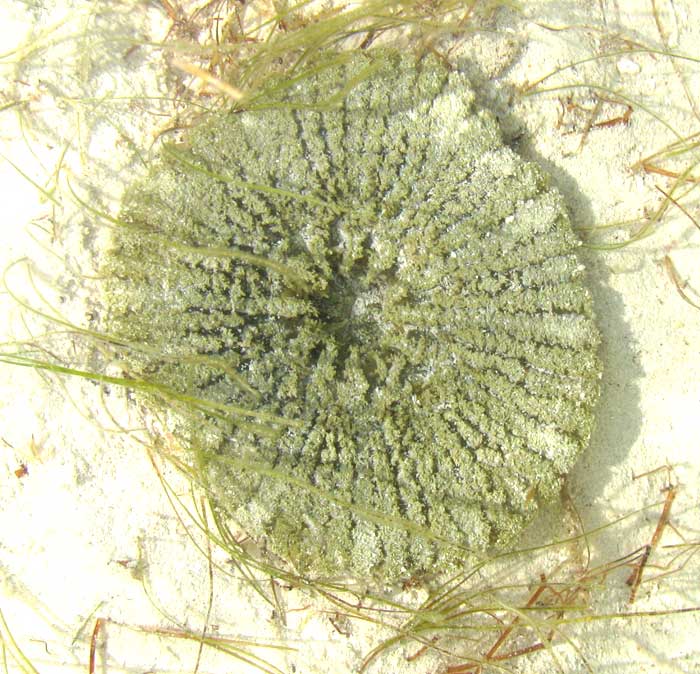Excerpts from Jim Conrad's
Naturalist Newsletter

from the May 22, 2011 Newsletter issued from Mayan Beach Garden Inn 20 kms north of Mahahual; Caribbean coastal beach and mangroves, ~N18.89°, ~W87.64°, Quintana Roo state, MÉXICO
CARPET ANEMONE
Soon after arriving here, at low tide and in shallow water in a sandy tide pool, I found two flat, round organisms the size of saucers. They felt like soft, crumbly mats of sand-coated jelly. You can see one above.
I wanted to take close-ups of the surface but camera-destroying waves irregularly washed in. Since this was my first walk along the beach at low tide, I figured I could always come back for more pictures, maybe when the tide was lower. But, though I've looked each day for nearly a month, I've never seen them again.
In Humann & Deloach's Reef Fish Identification: Florida, Caribbean, Bahamas no matches were found, though some features of its structure resembled "carpet anemones." Our picture was sent to a coastal expert in Florida who was stumped. Days passed and the expert showed the picture to other experts, until finally one day one opined that, yes, it looks like it could be a carpet anemone.
I'm guessing that we have the Caribbean Carpet Anemone, STICHODACTYLA HELIANTHUS, though other carpet anemones are found here. Internet pictures of the species look different because nearly always they're photographed on irregular rock surfaces where their bodies are not flat, not round, and not heavily blanketed with sand like ours. A picture of one in clear water on rocks and not covered with sand is shown here.
Now Google has taught me that sea aemones are water-dwelling, predatory animals. Helping make sense of our picture is Wikipedia's statement that "The mouth is in the middle of the oral disc surrounded by tentacles armed with many cnidocytes, which are cells that function as a defense and as a means to capture prey." So, that depression in the center must be where the mouth is, and the bumps around the mouth are fingerlike things with poisonous little darts in them used for capturing food and self-defense.
Elsewhere I read that "The mouth should be closed and tight, and will open when hungry, having an oval look, yet a gaping mouth is a warning signal." I should love to see this sand-strewn creature warning me with its gaping maw.
Also I read that beneath the mouth and tentacles lies a foot with which the anemone can move about. Maybe that's why ours were gone the next day.
What extraordinary creatures live on this beach!
An introduction to anemones in general, and a diagram of the anatomy of a carpet-like anemone, is at http://www.reefland.com/articles/rho/be-a-host-to-your-anemone.